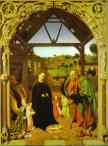Petrus Christus Biography
Petrus Christus, together with his elder contemporary Rogier van der Weyden, was the successor of the founders of the old Netherlandish school of painting: the van Eyck brothers and Campin. Most probably Christus was Jan van Eyck’s pupil; after the death of the teacher, in 1441, he took over the workshop and completed van Eyck’s unfinished pieces.
Though his works have many characteristics found in van Eyck's style, Petrus Christus significantly developed the Netherlandish school.
His importance today lies in his further development of the art of perspective. He was the first painter in the North who arrived empirically at the law of linear perspective and also applied it. He was also the first Dutch master, who started to paint portraits in rooms, against recognizable interiors, and not against a neutral background.
After Christus was made master and citizen of Bruges in 1444, van Eyck’s influence on him faded and was replaced by his interest in van der Weyden and Campin. His representation of background, often in the form of landscapes in a mood of quiet harmony, influenced later Netherlandish painters, in particular Bouts, Ouwater and Geertgen. Like Jan van Eyck, Christus was a considerable traveler, probably active in Milan, Venice, and Genoa as well as working for those centers’ mercantile colonies in Bruges.
There are 24 known works by Christus Petrus. The best collections are in Berlin and New York.
Bibliography
Painting of Europe. XIII-XX centuries. Encyclopedic Dictionary. Moscow. Iskusstvo. 1999.
- The Nativity.

c. 1445. Oil on wood. The National Gallery of Art, Washington, DC, USA. Read Note.